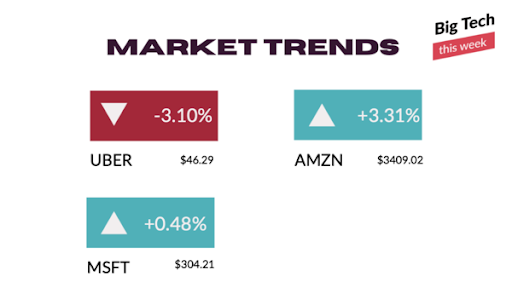Top of Mind. Happy Sunday!
Uber’s on a global world court tour, and it seems courts around the world all got the same memo to give Uber a whooping whenever they showed up on any dockets.
They made a tour stop in Kenya this week.
3 big things:
- Kenya’s high court sides with Uber drivers
- Amazon’s shady business practices
- LinkedIn gets the China treatment
Kenya’s high court has had it with Uber

The short: The High Court of Kenya ruled in favour of 34 Uber drivers who claimed that Uber’s group of companies violated its contractual agreement with them.
The story: Uber signed an agreement with Kenya drivers to retain a 25% cut of overall profits from each ride, with the base at a minimum of $0.54 per kilometre and a minimum fare of $2.71.
In July 2016, Uber reduced the minimum rate per kilometre to $0.32 and the minimum fare to $1.81 per trip, affecting the profits of these drivers.
According to the drivers, Uber reneged on the contract. Uber Kenya absolved itself of any responsibility and maintained the contract was signed with Uber KV, an Amsterdam-based company that owns the rights to the Uber app.
The verdict: While Uber Kenya maintains that it’s a separate legal entity from its Amsterdam counterpart and cannot be liable for the latter’s breach of contract, the High Court disagreed and lifted the “corporate veil” – establishing that both companies are linked and, as such, liable to the plaintiffs.
Big picture: Across the world, Uber’s infamous treatment of its drivers has landed it in several courts from South Africa to the UK.
In the UK…
Following a 5-year battle between Uber and a group of former drivers, the UK’s Supreme Court ruled Uber must treat drivers as full-time employees with employment rights like minimum wage and holiday pay – severely impacting Uber’s business model.
Why it matters: In Kenya, Uber’s latest offerings have been less considerate of the drivers. Uber introduced cheaper products at the expense of drivers’ revenues to keep up with competitors, causing a significant dip in revenue for drivers.
Final thoughts: Kenya’s High Court’s ruling offers better protections for Uber drivers reeling from the loss of earnings following the pandemic.
Uber’s best play in this instance is to honour the initial contract and offer up compensation on lost wages due to base-fair adjustments.
Amazon’s shady practices in India

The short: Reuters reviewed internal documents that revealed Amazon’s India division reportedly manipulated search results and copied products to promote its goods over local sellers.
What it means: These findings state that Amazon’s offerings in India might have been gotten off ‘inspiration’ from other brands who sell similar products on their platform.
Why it matters? Reuters’ investigation cites several internal documents, including a 2016 document titled “India Private Brands Program”. The company detailed how it reviews sales and customer data to identify “reference brands” to replicate.
Businesses in India have accused Amazon of manipulation in the past, and this revelation solidifies the perception of Amazon’s business practices in India.
Big Picture: The news is not lost on Amazon’s executives. In July 2020, Jeff Bezos spoke out against the practice, stating it was against Amazon’s business policy. However, the jury’s out on new CEO Andy Jassy’s strategy to curb Amazon’s anti-competitive behaviour in India.
Final Thoughts: Reuters investigation might be the catalyst that forces the government to protect its business community.
Whichever way India’s government chooses to handle this, it could create a domino effect across other markets, with countries taking a closer look at Amazon’s practices. I don’t think Amazon wants that level of scrutiny.
LinkedIn shuts down its China operations

The short: Microsoft announced LinkedIn would no longer offer its services in China, citing a challenging operating environment.
Why it matters: LinkedIn’s exit is the latest in a series of big-tech departures from the Communist country. Tech companies like Twitter and Facebook have been banned in China for over a decade. Google left in 2010 due to strict censorship rules.
LinkedIn gave it all… Since launching in China in 2014, LinkedIn has tried several means, including floating Chitu (a localised LinkedIn version that failed after two years) and recently censored China-focused human-rights activists, academics and journalists, to reconcile with the Chinese government’s strict demands.
Still wasn’t good enough.
What’s next? Later this year, LinkedIn will launch a jobs-only version of its site without the networking features to align with China’s control of online commentary.
Microsoft says:
While we are going to sunset the localised version of LinkedIn in China later this year, we will continue to have a strong presence in China to drive our new strategy and are excited to launch the new InJobs app later this year.“
Final thoughts: What do you say about a country that eats its own. China’s focus on product nationalism has been established for decades. No western tech company can change that.
I understand the allure of China’s 1.4billion+ population, but big tech companies must realise that there are markets you can’t thrive in. And that is okay.
Market Trends

Market Watch: Here’s how the stocks of companies, which dominated the news this week performed as of market close:
Uber (Ticker Symbol: UBER)
- Uber shed 3.10% of its value this week to $46.29 on a pretty rough trading session for the stock market. Uber closed $17.76 below its 52-week high of $64.05. Tsk tsk.
Amazon (Ticker Symbol: AMZN)
- Amazon’s adventures in India did nothing to their stock price. Stocks rose 3.31% to $3,409.02. The only way for Amazon to face repercussions is for India’s government to step in.
Microsoft (Ticker Symbol: MSFT)
- Shares of Microsoft demonstrated a mixed performance compared to its competitors. Nevertheless, shares rose 0.48% to $304.21 on what proved to be an all-around favourable trading session for the stock market.
New feature spotlight!

“Starting today, we’re trying something different and testing a new ad format in Tweet conversations. If you’re a part of this test (which is global; on iOS & Android only), you’ll see ads after the first, third or eighth reply under a Tweet. 🗣️ https://t.co/kvIGeYt2vp”
New feature alert: With plans to launch a future e-commerce feature, Twitter has rolled out new ad features and redesigned the algorithms that decide which ads users see.
How this works: Twitter will test out a new ad format in tweet conversations. Users who are part of the rollout will see ads after the first, third, or eighth reply under a tweet.
Verdict: This is Twitter’s version of ad breaks, which companies like Facebook and Instagram offer to creators on the platform. Essentially, if Twitter places an ad between your tweet, it should split the revenue with the tweet’s creator.
I’m curious about what the revenue share between Twitter and the creators would look like. It’s only fair creators get compensated.
––
That’s it for the week. See you next Sunday!
Please do us a solid by sharing the newsletter with your network of tech enthusiasts. Invite them to join the party 🙂

